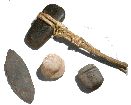 K nown to the Spanish as Gabrielino Indians
K nown to the Spanish as Gabrielino Indians
(named after
the Mission San Gabriel), they gathered shellfish, hunted
wild game, and made a flour-like meal out of acorns from the oak trees which grew in the area. The Suangna villagers lived peacefully, traded with their neighbors, and made tools, weapons and grinding implements from stone and other natural materials. Many of these objects were discovered at this site in Carson.
I n 1784, the village became part of the Rancho San Pedro (more generally known as the Dominguez Rancho), with some of the Indians working at the ranch as vaqueros.
B y the end of the 19th century, the plaque tells us, the village was no longer inhabited.